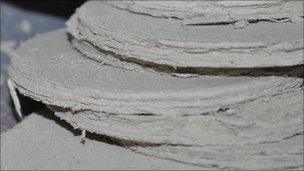Q&A: Asbestos
- Published

White asbestos is flaky and fibrous
Asbestos is a naturally occurring fibrous mineral. One form of asbestos, white asbestos, is widely used in the construction industry in the developing world, but is banned on health grounds in many industrialised countries. Other forms of asbestos - blue and brown - are banned worldwide.
What is it used for?
Asbestos is heat and flame resistant, strong and cheap, and has many uses. It can be mixed with cement for roofing and flooring. It is also used to insulate pipes and ceilings, and to make brake shoes and pads.
Is it dangerous?
Microscopic fragments of all kinds of asbestos fibre are potentially dangerous when inhaled and may give rise to asbestos-related diseases:
•lung cancer, which is more common in people exposed to asbestos
•mesothelioma, a cancer of the lining of the chest, which is extremely rare in people who have not been exposed to asbestos
•asbestosis, a lung disease that causes shortness of breath and may lead to respiratory failure
White asbestos, known as chrysotile, is the only form of asbestos mined and used today. The World Health Organisation says it too is associated with mesothelioma, lung and other cancers, but its promoters say it is safe if used properly.
Where is it used?
White asbestos is banned in the European Union, Australia and more than 20 other countries.
It is still used, in limited quantities, in the US and Canada. The biggest consumers, by far, are China, external, India, external and Russia, external. The main exporters are Russia, Kazakhstan, Brazil, external and Canada.
Can it be used safely?
Some experts say white asbestos has less potential for harm than brown or blue asbestos, but even trade organisations promoting white asbestos say workers should avoid inhaling dust. Whether any safe level of exposure exists is disputed. US workplace standards allow a maximum 0.1 asbestos fibres per cubic centimetre of air - but the US National Institute for Occupational Safety and Health estimates that exposure to this maximum level over a working life will cause five lung cancer deaths and two asbestosis deaths for every 1,000 workers.
How can workers be protected?
They can wear protective clothing, such as respirator masks. Measures can also be taken to lower dust levels in the workplace by the use of extraction fans, regular vacuuming or spraying to keep surfaces wet.
Are workers' families also at risk?
Those most at risk are workers exposed to high levels of asbestos dust over long periods. However, there are known cases where women have died from asbestos-related diseases after handling their husband's dirty work clothes. Children of workers also have died from such second-hand exposure.
How long do asbestos-related diseases take to develop?
Asbestosis can develop within a decade of initial exposure to asbestos, though often takes longer. Mesothelioma can take 30, 40 or even 50 years to appear. Doctors say patients diagnosed with mesothelioma have only a poor chance of surviving for five years.